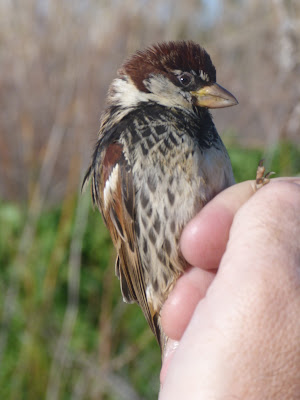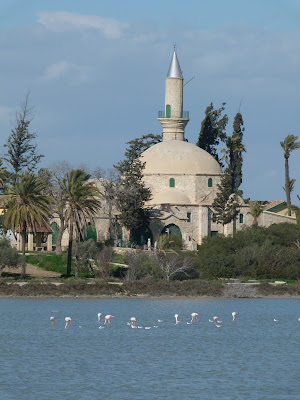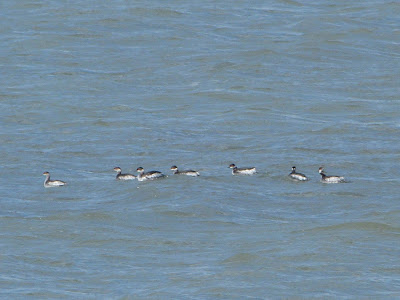3rd February
Another meeting with Graham at the fields adjacent to Paphos Sewage works at Acheleia. On the way down from the main road we had a very large female Peregrine sat in the filed that was possibly of the race
calidus.
We had a later start than normal and had a few nets in the hedgerow and in the Olive grove where birds are frequently seen to cut across from the hedgerow and out of the fields. It was clear that the Alfalfa had been cut the day before and this seemed to have an affect on the numbers of birds around. There was less about but we had a good proportion of recaptures, always important for really useful data.
Chiffchaff was the most frequently caught new bird (9), supported by Blackcap, Serin, Sardinian Warbler and Robin. There were also 11 retraps in all, comprised of Sardinian Warbler (6), Robin (3), Cetti's Warbler (1) and Blackcap (1).
A Sparrowhawk and Bluethroat were also seen.
Total: 25 (11)
Robin - 3 (3)
Cetti's Warbler - 0 (1)
Sardinian Warbler - 4 (6)
Blackcap - 4 (1)
Chiffchaff - 9
Goldfinch - 1
Serin - 4
Towards the end of the day we tried a likely drinking spot at Anarita Park. We were hoping to get a few Corn Bunting. We set a couple of two panel nets and settled down to wait. We could see the Corn Buntings gathering in their favoured trees further up the hill and it was looking very good until the sheep and goat flock drifted over in that direction with a shepherd looking for asparagus close to where the flocks were gathering. It wasn't long before they all departed and we caught nothing more than a few Chiffchaff and a Stonechat. We had a female Blue Rock Thrush on one of the small rocky mounds whilst sat in the car.
Total: 6
Stonechat -1
Chiffchaff - 5
4th February
This was to be the last day designated for a full morning's ringing and we returned to Neo Chorio to a site some distance from Agias Minhas, the area that we've ringed in the past. We managed to get a couple of doubles up with two more single full height nets. The species seen were different to those around the church, lots of Black Redstart being the main difference, with at least 17 seen, and still plenty of Robins, some Sardinian Warblers, and Stonechats, but not a single Chiffchaff to found.
5F Black Redstart
5F Stonechat
Recaptured 4F Sardinian Warbler 35372.
This is clearly, from the dark colouration, an old individual. We do not have access to the entire database but current rings are numbered 477** so we wonder exactly how many years ago it was ringed.
Afterwards we had a trip up along the Arodes plateau fields and picked up the resident Bonelli's Eagle, along with Sparrowhawk and Long-legged Buzzard, also decent sized flocks of Sky Lark and Chaffinches on some recently ploughed fields.
5th February.
Our final day in the Paphos area, so we just had a drive around a couple of sites. Mandria was fairly quiet with a single Buzzard, Red-throated Pipit, and a large Sky Lark flock of some 350 or so birds. We then just finished off with a final visit to Anarita Park which again held nothing special though the male Finsch's Wheatear was being particularly showy.
6th February.
We stopped off at a few places on route back to Larnaca airport, A quick stop off at Ladies Mile just on the off chance the Red Knot was still around, but we had no high expectations, and it wasn't. The usual flock of a couple of thousand Black-headed Gull was present, along with four Slender-billed, four Common, and at least 15 Armenian and a few Caspian Gulls. At Larnaca we had a look at Menou and Spiro's Pools which held a few Shelduck and common waders, including a Greenshank and 123 Golden Plover, plus two Spectacled Warblers were seen at Spiro's Pool. Finally a quick visit to Larnaca Sewage works which held briefly all the wintering Geese, with 51 Greylags and the eight White-fronted Geese, plus 33 Ruddy Shelduck, before they all flew off. Gulls were coming in all the time to bathe with at least 43 Caspian Gulls, several Armenian, and a single Heuglin's Gull, with the third winter Pallas' Gull still present. Fifteen Black-necked Grebes were now present, when we had none on our last visit.


















































